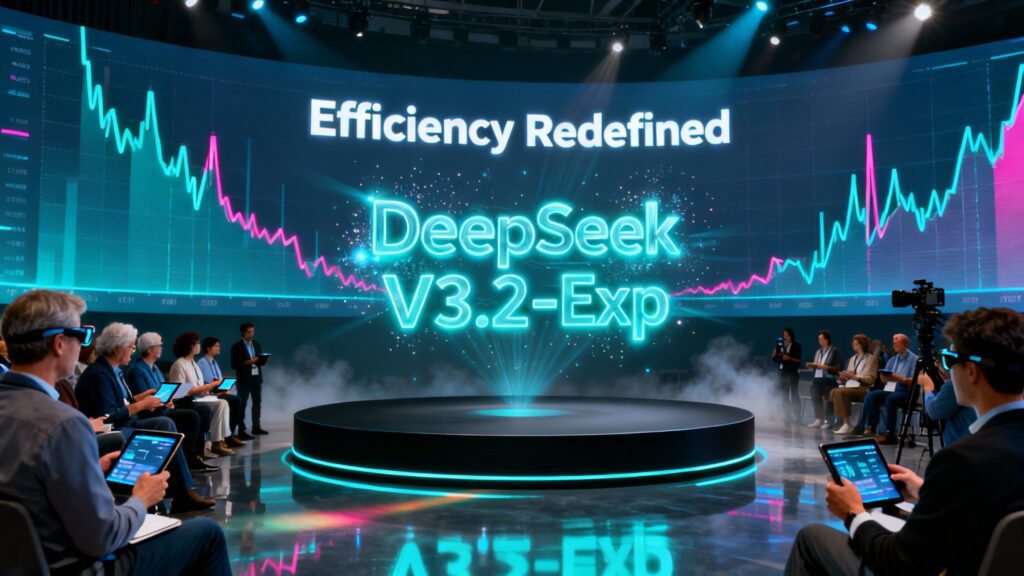
Chinese AI startup DeepSeek has once again shaken up the artificial intelligence landscape with the release of its groundbreaking V3.2-Exp model. The experimental large language model promises to slash API costs by more than 50% while maintaining comparable performance to its predecessor. This latest development positions DeepSeek as a formidable challenger to established AI giants like OpenAI and Anthropic.
Sparse Attention Technology Drives Innovation
The heart of DeepSeek’s latest breakthrough lies in its revolutionary DeepSeek Sparse Attention (DSA) technology. This innovative approach fundamentally changes how AI models process information, particularly when handling long-context operations.
Traditional attention mechanisms require computing relationships between every token and all other tokens in a sequence. This creates computational complexity of O(n²), making it resource-intensive and expensive. DSA breaks this paradigm by using what DeepSeek calls a “lightning indexer” to prioritize specific excerpts from the context window.
The system then employs a “fine-grained token selection system” that chooses specific tokens from within those excerpts. This selective approach allows the model to operate over long portions of context with significantly smaller server loads. The result? Dramatic cost reductions without sacrificing output quality.
Dramatic Price Cuts Reshape Market Dynamics
DeepSeek’s pricing strategy with V3.2-Exp represents a seismic shift in the AI API market. The company has introduced a cache-based differential pricing structure that makes AI more accessible than ever before. Input costs now start at just $0.028 per million tokens for cache hits, down from $0.07 in the previous model.
For cache misses, the pricing remains competitive at $0.28 per million input tokens. Output costs have also been reduced to $0.42 per million tokens. These prices represent a reduction of over 50% compared to the previous V3.1-Terminus model and are significantly lower than competitors like GPT-4, which costs around $30 per million tokens.
This aggressive pricing strategy reflects DeepSeek’s core value proposition: delivering powerful AI capabilities at a fraction of the cost of American competitors. The company’s approach could force industry-wide price adjustments as other providers struggle to match these economics.
Performance Benchmarks Show Maintained Quality
Despite the dramatic cost reductions, DeepSeek-V3.2-Exp maintains performance levels comparable to its predecessor across most evaluation metrics. The model performs on par with V3.1-Terminus on standard benchmarks, with some tasks showing marginal improvements.
In reasoning tasks without tool usage, the model achieved identical scores on MMLU-Pro (85.0) and showed improvements in mathematical competitions like AIME 2025 (89.3 vs 88.4) and Codeforces (2121 vs 2046). For agent tool usage scenarios, V3.2-Exp demonstrated enhanced performance in browser operations and multilingual software engineering tasks.
These results validate DeepSeek’s claim that sparse attention mechanisms can dramatically improve efficiency without compromising model capabilities. In some cases, the selective attention approach may even enhance performance by focusing computational resources on the most relevant information.
Technical Architecture Represents Major Breakthrough

The V3.2-Exp model builds upon DeepSeek’s 671-billion parameter V3.1-Terminus architecture while introducing fundamental changes to how attention is computed. The sparse attention mechanism represents years of research into making transformer architectures more efficient.
According to technical documentation, the system achieves 2-3x improvements in long-text inference speed while reducing memory usage by 30-40%. Training efficiency has improved by approximately 50%, contributing to the overall cost reductions that DeepSeek can pass on to users.
The model supports a context length of 128,000 tokens (roughly 300-400 pages of text) and can maintain cost efficiency even when approaching this limit. This makes it particularly attractive for applications requiring extensive document processing or long-form content generation.
Open Source Commitment Accelerates Innovation
DeepSeek has maintained its commitment to open-source development by releasing the complete model weights, inference code, and technical documentation on platforms like Hugging Face and GitHub. The company has also open-sourced key GPU kernels in both TileLang and CUDA, enabling researchers and developers to understand and build upon the sparse attention innovations.
This open approach contrasts sharply with the closed-source strategies of many Western AI companies. By making the technology freely available, DeepSeek is fostering a collaborative ecosystem that could accelerate further innovations in efficient AI architectures.
The open-source release includes deployment solutions for various hardware platforms, including support for domestic Chinese chips like Ascend and Cambricon. This hardware flexibility reduces dependence on specific GPU manufacturers and provides more deployment options for users worldwide.
Industry Implications and Competitive Response
DeepSeek’s latest release comes at a critical time in the AI industry’s evolution. As the initial excitement around large language models matures, attention is shifting toward efficiency and cost-effectiveness. The company’s focus on inference cost reduction addresses one of the most pressing challenges facing AI deployment at scale.
Nick Patience, VP and Practice Lead for AI at The Futurum Group, noted that “efficiency is becoming as important as raw power” in the current AI landscape. DeepSeek’s approach validates this trend and could influence how other companies prioritize their research and development efforts.
The pricing pressure created by V3.2-Exp may force established players to reconsider their cost structures. Companies like OpenAI, Anthropic, and Google may need to accelerate their own efficiency improvements or risk losing market share to more cost-effective alternatives.
Potential Concerns and Limitations
While the sparse attention approach offers significant benefits, some experts have raised concerns about potential trade-offs. Ekaterina Almasque, cofounder of BlankPage Capital, warned that sparse models may lose important nuances by excluding certain data points.
“The reality is, they have lost a lot of nuances,” Almasque noted, questioning whether the mechanisms for excluding information might inadvertently discard important data. This could potentially impact AI safety and inclusivity, particularly in applications requiring comprehensive understanding of complex contexts.
However, DeepSeek’s benchmark results suggest that these concerns may be overstated, at least for the tasks currently being evaluated. The company’s careful engineering of the sparse attention mechanism appears to preserve the most critical information while eliminating redundant computations.
Geopolitical Context and Strategic Implications
DeepSeek’s continued innovation occurs against the backdrop of intensifying AI competition between the United States and China. The company’s ability to achieve breakthrough performance at dramatically lower costs challenges assumptions about technological leadership and resource requirements in AI development.
The model’s compatibility with Chinese-made AI chips adds another dimension to its strategic importance. By reducing dependence on foreign hardware and offering cost-effective alternatives to Western AI services, DeepSeek is contributing to China’s broader goals of technological self-reliance.
For global users, this competition benefits everyone by driving innovation and reducing costs. The availability of high-quality, affordable AI services from multiple providers increases options and prevents any single company from dominating the market.
Future Roadmap and Next-Generation Architecture
DeepSeek has positioned V3.2-Exp as an “intermediate step toward our next-generation architecture,” suggesting that even more significant innovations are in development. The company plans to maintain API access to V3.1-Terminus until October 15, 2025, allowing users to compare performance and transition gradually.
The sparse attention technology introduced in V3.2-Exp likely represents just the beginning of DeepSeek’s architectural innovations. Future developments may include more sophisticated sparse patterns, enhanced mixture-of-experts systems, and multimodal capabilities that extend beyond text processing.
The company’s roadmap also includes development of R2 agent capabilities and support for the Model Context Protocol (MCP), positioning DeepSeek to compete in the growing market for AI agents and autonomous systems.
Deployment Options and Accessibility
DeepSeek has made V3.2-Exp accessible through multiple deployment options, catering to different user needs and technical requirements. The model is available through the company’s API, web interface, and mobile applications, with immediate access to the cost reductions.
For organizations requiring on-premises deployment, DeepSeek provides comprehensive documentation and support for various hardware configurations. The company offers Docker images optimized for different GPU platforms, including NVIDIA H200, AMD MI350, and domestic Chinese NPU chips.
This flexibility in deployment options, combined with the dramatic cost reductions, makes advanced AI capabilities accessible to a broader range of organizations, from startups to large enterprises.
Market Impact and Industry Transformation

The release of DeepSeek V3.2-Exp represents more than just another model update it signals a fundamental shift in how the AI industry approaches efficiency and pricing. By demonstrating that cutting-edge performance can be achieved at dramatically lower costs, DeepSeek is forcing the entire industry to reconsider its assumptions about AI economics.
The sparse attention breakthrough could inspire similar innovations from other companies, potentially leading to an industry-wide focus on efficiency improvements. This competition benefits users through lower costs and better performance, while also making AI more accessible to organizations with limited budgets.
As the AI industry continues to mature, DeepSeek’s approach of combining technical innovation with aggressive pricing may become the new standard for competitive success. The company’s latest release demonstrates that the future of AI may belong not to those with the largest budgets, but to those with the most efficient architectures.
Sources
- TechCrunch – DeepSeek releases ‘sparse attention’ model that cuts API costs in half
- CNBC – China’s DeepSeek launches next-gen AI model. Here’s what makes it different
- VentureBeat – DeepSeek’s new V3.2-Exp model cuts API pricing in half to less than 3 cents per 1M input tokens
- DeepSeek API Docs – Introducing DeepSeek-V3.2-Exp
- The Decoder – DeepSeek slashes API prices by up to 75 percent with its latest V3.2 model









